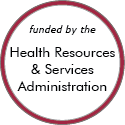Utah Models and Innovations
These stories feature model programs and successful rural projects that can serve as a source of ideas. Some of the projects or programs may no longer be active. Read about the criteria and evidence-base for programs included.
Effective Examples
New Mexico Mobile Screening Program for Miners


Updated/reviewed April 2025
- Need: To increase access to medical screening for miners in New Mexico.
- Intervention: A mobile screening clinic with telemedicine capability screens miners for respiratory and other conditions.
- Results: In a survey, 92% of miners reported their care as very good, while the other 8% reported it as good. The program has expanded to three other states.
Other Project Examples
Hope Squad
Updated/reviewed June 2025
- Need: To reduce youth suicide rates.
- Intervention: First begun in Utah, Hope Squad is a nationwide program that trains youth to identify peers' signs of distress and connect them to help. Hope Squads educate the entire student body to increase connectedness and reduce stigma.
- Results: Studies suggest that Hope Squad schools' students with suicidal thoughts are more likely than non-Hope Squad schools' students to solicit help. In addition, stigma surrounding mental illness is decreasing.
Canyon Creek Services
Updated/reviewed April 2025
- Need: To reduce and prevent domestic violence and sexual assault in Utah's rural Beaver, Garfield, and Iron counties.
- Intervention: Canyon Creek Services provides a 24/7 emergency hotline, emergency shelter, hospital response, crisis intervention, housing advocacy, and community education services.
- Results: In 2024, CCS served 742 clients, received 1,063 hotline calls, and provided 4,988 hours of advocacy. CCS also provided 21 educational trainings in the community, with 1,125 people in attendance.
Utah Rural Independent Hospital Network (Rural 9 Network)

Updated/reviewed December 2024
- Need: To help ensure the viability of and improve quality at 9 rural, independent hospitals serving 11 Utah counties.
- Intervention: A network organization was created to allow member hospitals to communicate, network, and undertake projects together.
- Results: Members take advantage of cost savings, education, and networking opportunities through group projects and programs.
Last Reviewed: 12/29/2023

